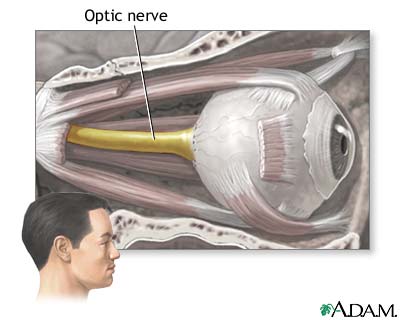Optic nerve atrophy treatment

Optic nerve atrophy is a process of dying of nerve fibers of the eye optic nerve, which leads to partial or complete loss of vision. Atrophy of the optic nerve is a pathological condition that occurs as a distinct disease or as a result of exposure to the nerve of other pathologies.
Range of treatment methods of illness is as wide as the main reasons for its occurrence. Most methods are aimed at reducing or eliminating pathological influence, which led to the emergence of the illness.
The main methods of influencing the pathological process in the optic nerve atrophy are:
Medications - aimed at improving the trophism of the optic nerve and retina, eliminating inflammation and edema reduction.
Action of medicines is directed to:
- Stop the inflammatory processes by means of hormonal preparations;
- Improvement of metabolism in nerve tissues and stimulation it`s functioning with the help of vitamins, enzymes, amino acids and immunostimulants;
- Treatment of diseases of the central nervous system associated with the appearance of optic nerve atrophy.
Methods of administration of the preparations are varied: intravenous, intramuscular, local injections, eye drops, tablets.
Physiotherapy - electrophoresis, magnetic or laser stimulation of the optic nerve and retina, acupuncture, oxygen therapy.
Success of treatment of optic nerve atrophy directly depends on the start of treatment up to complete loss of vision, on the maximum possible early stages of the disease. In fact, the treatment should be carried out up to complete loss of optic nerve conduction. If all nerve endings of the optic nerve due to atrophy become connective tissue – vision regeneration is almost impossible. There are conditions when the nerve is still alive, but a person does not see anything because of the pathological processes outside the optic nerve. Such a situation may occur for some time after vision disappearance. Instrumental methods of examination can confirm that the nerve is alive and then the treatment should be initiated as soon as possible.
Diagnostics of optic nerve atrophy
In most cases, the process of atrophy of the optic nerve is stretched in time and the first symptoms appear long before the onset of severe atrophy and complete loss of vision. Therefore, in case of appearance of the first symptoms of the disease, a person should immediately consult an ophthalmologist and neurologist.
The main methods of diagnostics of this disease are ophthalmic methods. In examination are defined fields of vision and its acuity. Ophthalmoscopy also can reveal narrowing of vessels of ocular fundus and pallor of the optic disc. Ophthalmologist checks intraocular pressure and performs a color transfer analysis.
For a more accurate diagnosis of optic nerve atrophy are applied instrumental methods of examination.
X-ray method - craniography of the sella area;
Magnetic resonance imaging, computed tomography of the brain allow not only to identify diseases leading to atrophy, but also applying fluorescent-angiographic techniques with use of contrast agent to investigate retinal vascular permeability.
Laboratory blood tests: general and biochemical analysis, PCR studies (to confirm or refute presence of inflammation and infection).
Stem cell treatment for optic nerve atrophy
Most of the currently used traditional methods of treatment are only able to slow or stop atrophy of the optic nerve. At that, further loss of vision is suspended, but there is no regeneration possible.
Specialists of the Unique Cell Treatment Clinic, led by Professor Smikodub, developed a highly effective method of treatment for this disease with the use of preparations based on fetal stem cells.
With the optic nerve disorder there is a situation when the body does not have enough own resources for regeneration of nerve fibers and replacement of dead nerve endings by the new ones.
Applied preparation on the basis of fetal stem cells contains millions of neuroectodermal stem cells of natural origin, these stem cells are precursor cells of neurons that build the nerve endings, including the optic nerve. After being injected, stem cells form stable pools of stem cells that constantly produce offspring and are able within a year and a half to supply the body with neuronal progenitor cells. Stem cells of fetal origin are the age at which they have not yet developed their own immune system, and they are perceived by the patient’s body as its own cells. Rejection reaction does not occur.
Our treatment is resulted in restoration of the optic nerve, which is unattainable by other modern methods of treatment. In our clinic, treatment with fetal stem cells is performed in conjunction with the standard treatment of the underlying disease that caused atrophy of the optic nerve.
Our twenty years of experience in treatment of the illness testifies to the success that is unattainable by other modern treatment methods.
Our clinic did not get positive results in complete atrophy of the optic nerve, but if even small part of non-atrophied nerve fibers remained, we observed successful vision recovery. In a number of severe pathologies and severe atrophy, positive results are achieved longer. If the treatment was started at the early stages of optic nerve atrophy, it is observed a fairly rapid progress in restoring vision.
Our clinic performs modern diagnostic examinations of all patients. Treatment is easily tolerated by the patients and has no side effects.
Treatment of optic nerve atrophy in the Unique Cell Treatment Clinic depending on the severity of the patient's condition takes from 3 to 5 days.